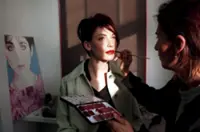And because hair is never just hair – it’s a repository of all sorts of cultural preconceptions. Photo: Pexels
It is true that we are in a Rapunzel age – or at least it often looks as if we are.
The new Gucci film, the one that showcases Demna’s first collection, had its premiere during Milan Fashion Week and stars Demi Moore, doyenne of long, dark flowing locks.
The week before, president Donald Trump made an official visit to Britain, and at the state banquet Melania Trump and Catherine, Princess of Wales, wore their (yes) long, flowing brown hair down.
Indeed, long hair has become something of a signature for many women in the Trump administration and orbit, and thus in the news, including Kristi Noem, Karoline Leavitt and Lara Trump.
And it has become something of a declaration of independence and self for Michelle Obama, who traded her ironed-out White House bob for cascading power braids once she left the White House.
It’s all a pretty big shift from a time when, as Linda Wells, editor of Air Mail Look (and founding editor of Allure), said, “Women were told that the older they get, the shorter their hair should be.”
Read more: Effortless yet polished: The season’s hair trends for every mood and style
Just consider the fact that Melania Trump is the first first lady in the modern era to have hair below her shoulders.
And because hair is never just hair – it’s a repository of all sorts of cultural preconceptions – the change represents not just a beauty trend but also a larger shift in ideas about gender, status, race and age.
“Long hair has its own deep history and is synonymous with a breadth of understood codes – religious, countercultural and classically feminine,” Duffy, the hair guru behind the runway looks of Chanel, Celine and Alaia, said when I asked.
For decades, at least in the Eurocentric tradition, long hair for women was associated with childhood, maidenhood and fertility. As a result, cutting it, or at least pinning it up, was a sign of maturity, of becoming part of the establishment.
It was also a badge of modernity since it was only with the advent of the hair salon that stylish cuts became available to the masses.
Conversely, leaving one’s hair long was a way of signaling rebellion against the establishment – see the musical Hair – or, more recently, pushing back on old stereotypes.
Now, Wells said, the preponderance of longer styles also reflects somewhat different phenomena.
The most obvious is the swing toward not just conservatism but also tradwife presentation, in which long hair is a key element. But issues of money and economic inequality are part of the story.
After all, Wells pointed out, “long hair is a flex”.
She added, “It requires good health and a certain amount of money to maintain its shiny lushness.”
Some hair stylists, she said, even have a name for it: “rich girl’s hair”.
Read more: Ever wondered why your hair seems to thin as you age? Here's what experts say
This is exacerbated by age since hormonal changes, especially a lack of estrogen after menopause, often result in drier, thinner hair. Keeping it short was traditionally a way to solve the biological problem.
New treatments have sought to address the issue – but again, for those that can afford them.
“Hair supplements like Nutrafol and Omi have taken off in recent years,” Wells said, along with serums, masks and multiproduct routines.
“There’s no undisputed scientific evidence that these treatments actually encourage hair growth,” she added, “But their popularity is proof that there’s an audience for the products.”
And that the long hair-aissance may not be ending any time soon. – Vanessa Friedman/©2025 The New York Times Company
This article originally appeared in The New York Times.







